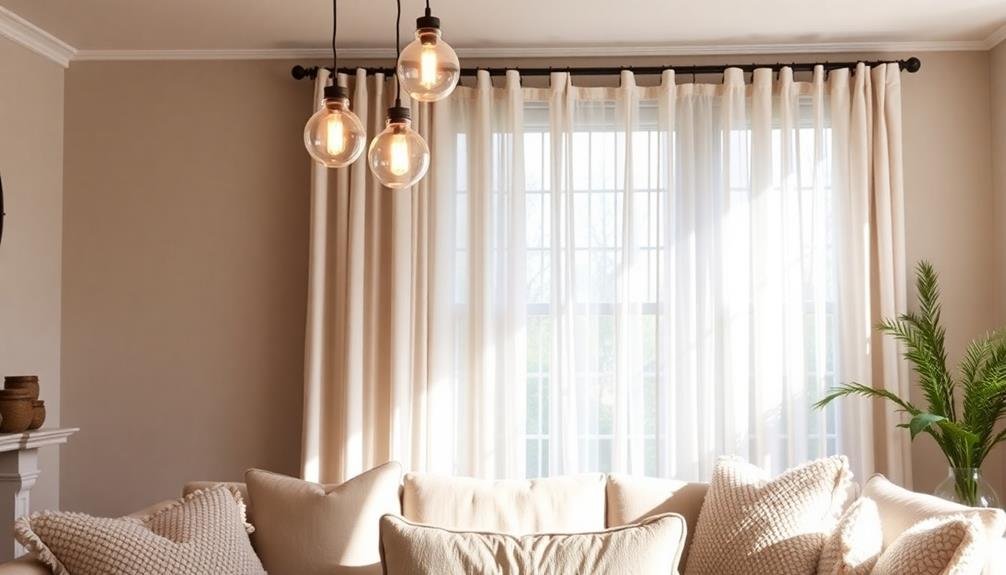To create a peaceful atmosphere with lighting, start by using warm, soft light sources like LED bulbs or table lamps. These provide inviting illumination that fosters relaxation. Incorporate natural light by using sheer curtains, and consider adding plants for increased calmness. You might also use dimmer switches to easily adjust brightness based on your mood. Layering different light sources enhances functionality while maintaining a serene environment. Remember, warm color temperatures below 3000K are ideal for cozy spaces, while cooler temperatures work better in work areas. Explore various lighting options, and you'll discover how they transform your surroundings.
Understanding Light's Impact
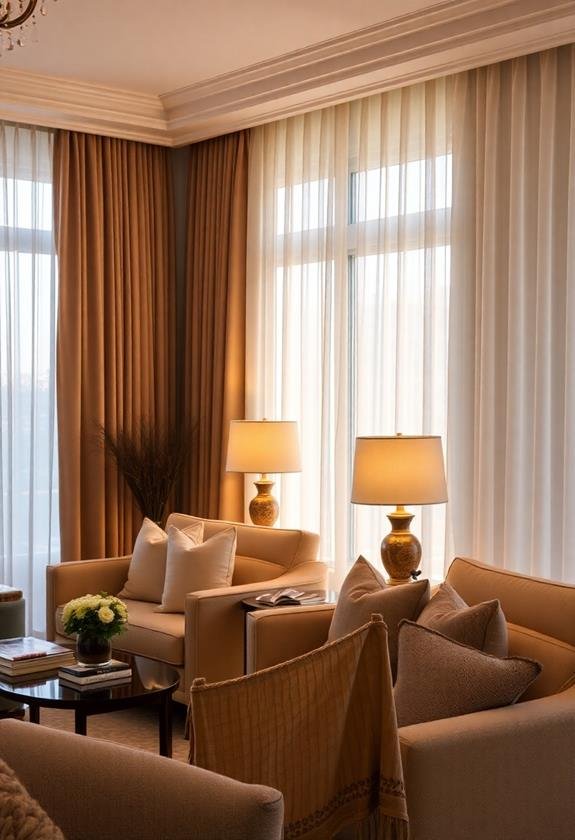
Light plays an essential role in shaping our mood and perception of space. When you walk into a room, the type and intensity of light can instantly create a feeling of comfort or unease. Natural light, for instance, often brings warmth and positivity, making you feel more energized and alert. In contrast, harsh fluorescent lighting can feel cold and sterile, which might lead to feelings of stress or discomfort. Incorporating elements like LED string lights for bedrooms can also enhance the ambiance, adding a touch of coziness and charm to your personal space.
The color temperature of light also influences your emotions. Warm tones, such as soft yellows and oranges, foster a sense of relaxation, while cooler tones like blues and greens can evoke serenity but may also feel more clinical. Think about how you feel in a cozy café with warm lighting compared to a brightly lit office; the difference is striking.
Moreover, the placement of light sources can alter your perception of space. Properly positioned lights can make a small room feel larger or highlight certain areas, enhancing the overall atmosphere. By being mindful of these aspects, you can harness the power of light to create a peaceful environment that nurtures both your well-being and creativity. Understanding how light impacts your surroundings enables you to design spaces that promote calmness and comfort.
Choosing the Right Light Sources

Selecting the right light sources is essential for creating a serene atmosphere in your space. The type of lighting you choose can greatly affect your mood and overall comfort. To help you make the best choices, consider these four key light sources that can enhance calmness:
- Soft LED Bulbs: These bulbs emit a warm, inviting glow. They're energy-efficient and can create a soothing ambiance, especially in bedrooms or living areas. For a wider selection of options, check out lighting fixtures for relaxing ambiance.
- Table Lamps: Place them strategically around your room to provide focused, gentle lighting. A well-placed table lamp can serve as a comforting reading nook, inviting relaxation.
- Dimmable Fixtures: Incorporating dimmable lights allows you to adjust the brightness according to your needs. You can create a vibrant environment during the day and a soothing atmosphere at night.
- String Lights: These add a whimsical touch while providing soft illumination. They're perfect for draping around furniture or hanging on walls, offering a cozy feel without overwhelming brightness.
Embracing Natural Light
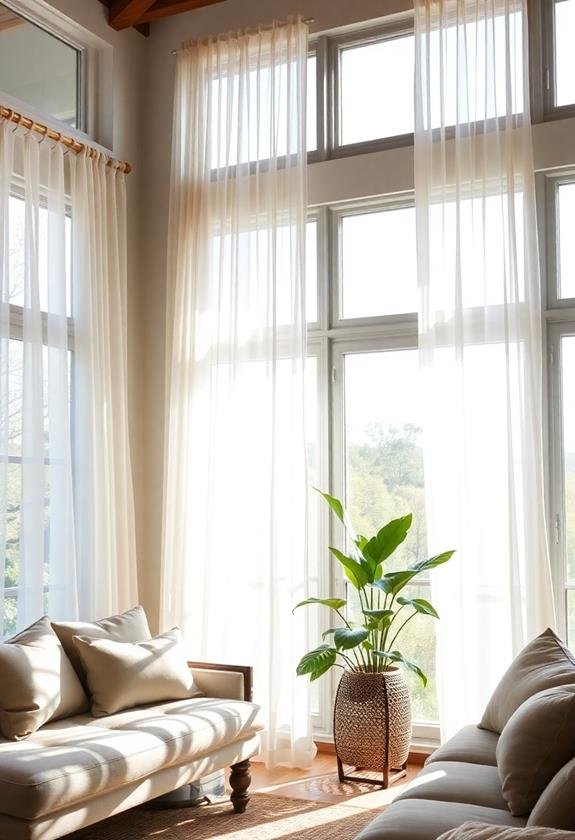
Embracing Natural Light
Natural light plays an essential role in creating a peaceful atmosphere in your home. By allowing natural light to flood your spaces, you can enhance your mood, reduce stress levels, and promote a sense of well-being. Incorporating houseplants can further improve air quality, making your environment even more rejuvenating and serene, as breathe easier with houseplants contributes to a calming environment. Start by strategically placing mirrors opposite windows to reflect sunlight, making your rooms feel brighter and more open.
Open your curtains or blinds during the day to take full advantage of daylight, and consider using sheer window treatments for privacy while still letting light in. If possible, choose a home layout that maximizes sunlight exposure, perhaps by selecting rooms with large windows or skylights.
You might also consider the orientation of your home; south-facing windows usually capture the most sunlight throughout the day. Additionally, incorporating plants can further elevate your atmosphere, as they thrive in natural light and contribute to a calming environment.
Embracing natural light not only brightens your living spaces but also connects you to the outside world. The gentle shift of daylight offers a comforting rhythm to your day, creating a serene backdrop for relaxation and mindfulness.
Utilizing Soft Lighting
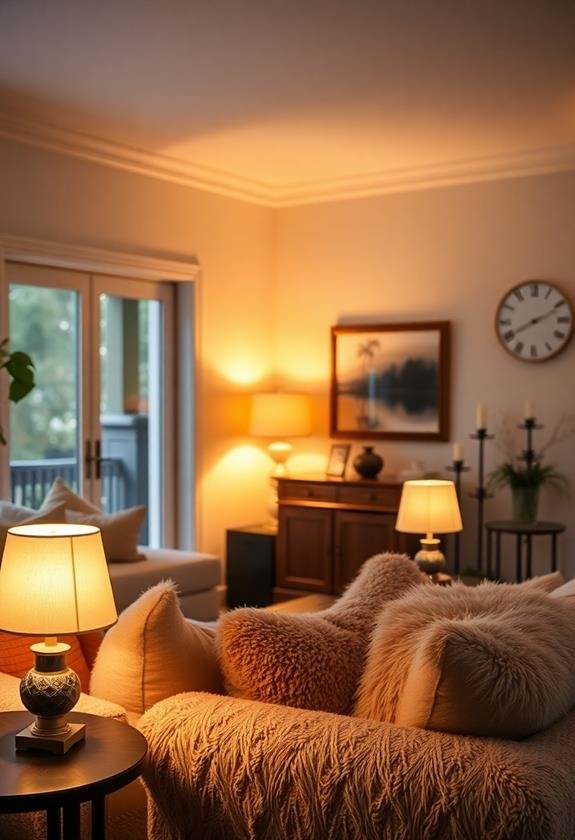
To complement the benefits of natural light, incorporating soft lighting can considerably enhance the peaceful atmosphere in your home. Soft lighting creates a warm, inviting environment, reducing harsh contrasts and promoting relaxation. You can easily achieve this calming effect through a few strategic choices.
- Use Lamps with Warm Bulbs: Opt for lamps that emit soft, warm light rather than cool, bright bulbs. This can create an inviting glow that feels cozy.
- Incorporate Fairy Lights: String lights or fairy lights can add a whimsical touch while providing gentle illumination. Hang them around windows or drape them across furniture for a magical effect.
- Utilize Floor and Table Lamps: Instead of relying solely on overhead lighting, use floor and table lamps to distribute light more evenly throughout the room. This helps avoid harsh shadows.
- Choose Soft Shades: Lampshades made of fabric or paper can diffuse light beautifully. Opt for lighter colors to enhance brightness without overwhelming the space.
Incorporating Dimmer Switches
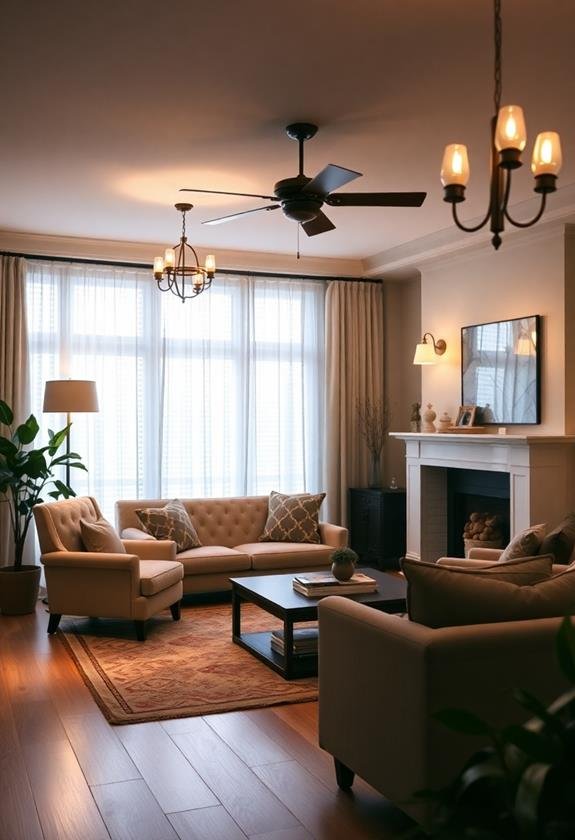
Adding dimmer switches to your lighting setup can transform the way you experience your home. By allowing you to adjust the brightness of your lights, dimmers help create a calm and inviting atmosphere tailored to your mood and activities. For instance, after a long day, you might prefer a soft glow that promotes relaxation, while during a lively gathering, brighter lights can energize the space.
Installing dimmer switches is relatively straightforward and can be done with basic tools. You'll need to turn off the power, remove the existing switch, and connect the dimmer according to the manufacturer's instructions. Once installed, you'll quickly appreciate the versatility and control they provide. You can easily shift from bright lighting for tasks like reading or cooking to a warm ambiance perfect for winding down in the evening.
Additionally, dimmers can help save energy and extend the lifespan of your bulbs, making them a practical choice. Whether you're hosting a dinner party or enjoying a quiet night in, having the ability to control your lighting can greatly enhance your overall experience and contribute to a more peaceful atmosphere in your home.
Adding Accent Lighting
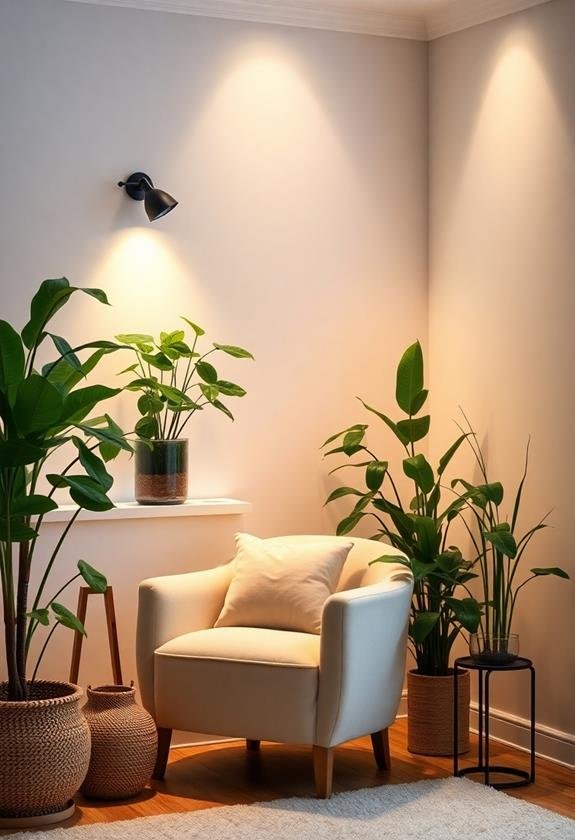
Accent lighting can dramatically enhance the aesthetic appeal of your space while also contributing to a peaceful atmosphere. By strategically placing light sources, you can create focal points that draw attention without overwhelming your senses. Here are four effective ways to incorporate accent lighting into your home:
- Table Lamps: Use soft-glow table lamps to illuminate reading nooks or side tables. These can create cozy spots perfect for relaxation.
- Wall Sconces: Install wall sconces in hallways or above artwork. The gentle illumination not only highlights your decor but also adds a warm ambiance.
- LED Strip Lights: Consider adding LED strip lights under shelves or cabinets. This subtle lighting option can add depth to your space, making it feel inviting and spacious.
- Candles: Incorporate candles for a natural, flickering light source. They evoke a sense of calm and can be strategically placed throughout your home to enhance peace.
Color Temperature Considerations
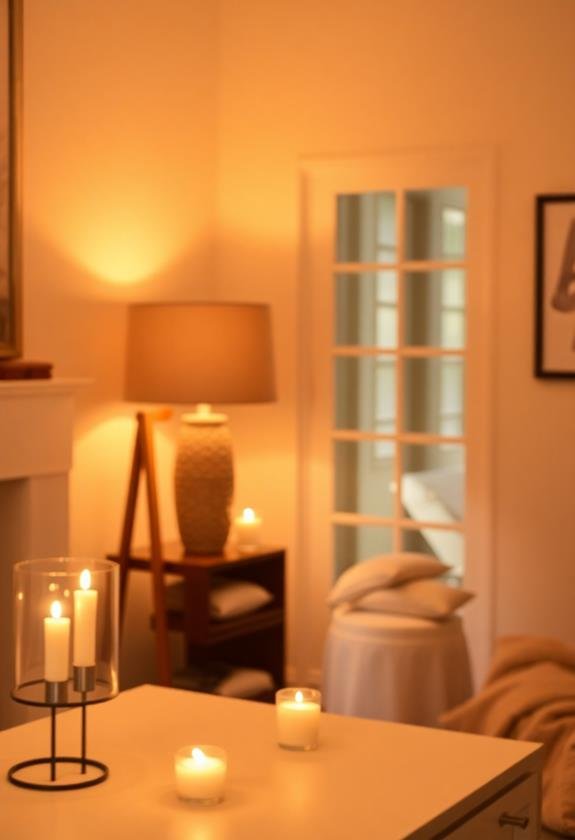
Choosing the right color temperature for your lighting can greatly influence the mood of your space. Color temperature is measured in Kelvins (K) and ranges from warm to cool tones. Warmer light, typically around 2700K to 3000K, creates a cozy, inviting atmosphere that's perfect for bedrooms or living rooms. This soft glow encourages relaxation and comfort, making it ideal for winding down after a long day.
On the other hand, cooler light, ranging from 4000K to 5000K, tends to be more energizing and stimulating. This type of lighting works well in kitchens or workspaces, where you need to stay alert and focused. However, using cooler lighting in areas meant for relaxation can create a more stressful environment.
To strike a balance, consider using dimmable lights or layering different color temperatures in your space. For instance, you might have warm overhead lights combined with cool task lighting for reading. This approach allows you to adjust the atmosphere according to your needs, ensuring you always feel at ease. Ultimately, paying attention to color temperature can transform your environment, making it a sanctuary for peace and serenity.
Frequently Asked Questions
How Does Lighting Affect Mood and Emotions?
Lighting considerably impacts your mood and emotions. For instance, bright, harsh lights can evoke feelings of stress or anxiety, while soft, warm lighting tends to create a sense of calm and relaxation. You might notice how dimming the lights in a room can make you feel more comfortable and at ease. Additionally, natural light can boost your energy and improve your overall mood, highlighting the profound connection between lighting and emotional well-being.
Can Specific Light Colors Promote Relaxation?
Bright, harsh lights can energize you, while softer, muted colors create a calming effect. Specific light colors, like soft blues and greens, promote relaxation by mimicking nature's soothing hues. When you surround yourself with these colors, your body responds, reducing stress and enhancing your mood. Imagine winding down in a room bathed in gentle blue light; you'll likely feel your tension ease. Using the right colors can truly transform your environment into a peaceful sanctuary.
What Are the Best Light Fixtures for Tranquility?
When it comes to creating calmness, consider using soft, warm light fixtures such as table lamps or pendant lights with dimmers. These allow you to adjust brightness to suit your mood. LED strips can also provide gentle illumination around rooms, enhancing a soothing ambiance. Additionally, fixtures with soft shades diffuse light, reducing harsh shadows and glare. By thoughtfully selecting your light sources, you can greatly influence your environment and promote relaxation.
How Can I Adjust Lighting for Different Times of Day?
Adjusting your lighting throughout the day is like tuning an instrument; each change creates a different harmony. In the morning, let natural light pour in, boosting your energy. As the day wanes, switch to softer, warmer bulbs to promote relaxation. At night, dimming fixtures or using lamps can create a cozy ambiance. Remember, using layered lighting—overhead, task, and accent—allows you to tailor the atmosphere to your activities and mood effectively.
Are There Specific Lighting Styles That Enhance Peace?
When you think about lighting styles that enhance serenity, consider soft, warm tones, like those from lamps with soft shades. These create a cozy, inviting environment. You might also explore string lights or candles, which add a gentle glow, promoting relaxation. Natural light is essential too; using sheer curtains can help filter it beautifully during the day. Overall, layering these lighting options can create an atmosphere that encourages peace and calmness in your space.

